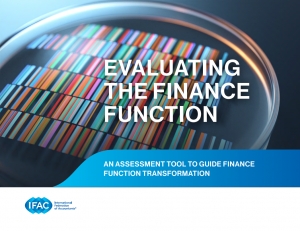عرض العناصر حسب علامة : الحوكمة
رسالة ماجستير: تحليل العلاقة بين غموض التقارير المالية، أداء المسئولية الاجتماعية، وممارسات التجنب الضريبى، وبين خطر الانهيار المستقبلى لأسعار أسهم الشرکات ذات التصنيف فى مؤشر البورصة المصرية للاستدامة
معلومات إضافية
- البلد مصر
رسالة ماجستير: تحليل العلاقة بين غموض التقارير المالية، أداء المسئولية الاجتماعية، وممارسات التجنب الضريبي وبين خطر الانهيار المستقبلي لأسعار أسهم الشركات ذات التصنيف في مؤشر البورصة المصرية للاستدامة
تمثل هدف القضية البحثية المطروحة من قبل الدراسة الحالية، في اختبار اتجاه وقوة ودلالة العلاقة بين كل من مستوى غموض التقارير المالية، أداء المسئولية الاجتماعية، ودرجة ممارسات التجنب الضريبي، وبين احتمال حدوث خطر الانهيار المستقبلي لسعر سهم الشركة من جهة
أدوات التحويل الحاكمة
مع اعتماد المزيد من المؤسسات للتحليلات والأتمتة، يمكن للمدققين الداخليين المساعدة في تقييم المخاطر وإنشاء إطار عمل للحوكمة.
معلومات إضافية
-
المحتوى بالإنجليزية
Governing Transformative Tools
As more organizations adopt analytics and automation, internal auditors can assist in assessing risks and establishing a governance framework.
Gregory Kogan, Daniel Gaydon, and Douglas M. BoyleOctober 14, 2021Comments
Competitive excellence demands the implementation of data analytics and automation technologies, such as robotic process automation (RPA) and self-service data analytics. These technologies allow organizations to collate and analyze data from massive data sets that are too large to compile in database and spreadsheet applications. In some cases, they can download a trial version and quickly build databases.
Applications like this have driven global organizations to increase their investments in data analytics and automation technologies to streamline repetitive manual processes into powerful and effective automated processes. Annual worldwide spending on RPA technology is projected to grow from $3.6 billion to $42 billion over the next five years, according to Zinnov, a global management consulting company based in Bangalore, India.
Yet, while intelligent automation can provide significant financial and operational benefits, it also can cause considerable reputational, regulatory, financial, and operational damage when it goes wrong. For example, if automation is left unattended, it could lead to errors in critical processes that affect accounting and financial reporting outputs. Internal audit can assist executives and the board in assessing these risks and establishing a governance framework in anticipation of exponential organizationwide adoption of automation and analytics applications.
MEASURING ROI
The driving force behind investments in process automation lies in the potential for realizing large annual cost savings, especially when these technologies are scaled throughout the organization. “For a mid-table Fortune 1000 organization with around $20 billion in revenue and 50,000 employees, automating 20% of estimated addressable activity through RPA could result in $30 million of bottom-line impact each year,” Deloitte reports in The Robots Are Ready. Are You?
C-level executives responding to a 2020 Protiviti survey say the biggest benefits of process automation include increased productivity, better quality, stronger competitive market position, higher customer satisfaction, greater speed, and employee satisfaction from elimination of mundane tasks. However, respondents report encountering obstacles such as inability to prioritize potential RPA initiatives, concerns about cybersecurity and data privacy, high implementation costs, difficulty in scaling applications, and making a convincing business case.
While the development time of RPA projects typically ranges from several weeks to a few months, self-service data analytics projects can be deployed even faster. Simple processes can be automated within a few hours or a few days.
Traditionally, return on investment (ROI) on automation is measured by how many hours are saved. Both RPA and self-service analytics have demonstrated high ROI, when comparing resources invested in the automation projects to the value returned through capacity creation and efficiency. Value is realized by redeploying employee hours saved elsewhere, contributing to organizational productivity (see “Capabilities of RPA and Self-service Data Analytics” below).
ASSESSING RISK
To maintain risk transparency, it is essential for internal audit to create a risk-scoring mechanism that assesses each automation project based on applicable risk dimensions. Starting with the model risk methodology Allan Sammy describes in his June 2018 Internal Auditor article, “Auditing Analytic Models,” his scorecard can be expanded to include key metrics specifically pointed toward automated accounting and finance processes:
Complexity. If the automation deployment is more complex in terms of processing steps, technologically, or is specialized/customized in a way that makes it more intricate, these deployments score higher on the complexity scale.
Economic loss. An increased level of precision is required when failure could result in a direct or explicit economic loss to a client or counterparty.
Consumer. Regulatory risk will be higher if the automation deployment produces outputs for reports that are intended for external regulators and will be audited
or examined.
Success rate. A historical computation compiles the success rate of the automation run over a prescribed reporting period, such as a month, quarter, or year.
Dependency. When automation deployments produce outputs that serve as inputs into other automation deployments, dependency is higher, because an error in this type of automation will permeate other processes.
“Risk Assessment of an Automated Process” (below) is an example of how a scorecard can be applied in an accounting or finance department. Each unique automation deployment risk is scored according to five dimensions unique to the automation environment of those functions. Internal auditors can use this method to assess the risk of each individual automation project deployment, which is usually related to a specific process such as a bank reconciliation.
Because each automation deployment has a different degree of risk related to complexity, economic loss, ultimate consumer, success rate, and dependency, each project will carry a risk score across these five dimensions. By documenting the total risk of individual projects and their related processes, internal auditors can provide management with risk transparency over the automation portfolio and design risk responses strategically.
GOVERNING THE DIGITAL ENVIRONMENT
As companies deploy automation and analytics to accelerate routine processes and create efficiency, the biggest threat to success in scaling these programs is the lack of governance over the risks and controls in this new digital environment. Many organizations that have embraced digital transformation may still be operating under fragmented legacy governance structures that have failed to keep pace with the growth in data analytics tools. Worse yet, governance may be an afterthought, even as build after build propagates dependency after dependency, incrementally adding risk to the data analytics portfolio.
This governance vacuum is compounded by a regulatory gap. For example, in the highly regulated world of accounting and finance, currently there is a lack of specific regulations or guidance on how to establish stable governance and internal controls for automated processes.
Companies are subject to a variety of regulations and governance frameworks such as Section 404 of the U.S. Sarbanes-Oxley Act of 2002, The Committee of Sponsoring Organizations of the Treadway Commission’s Internal Control–Integrated Framework and Enterprise Risk Management–Integrating
With Strategy and Performance, and the U.S. Federal Reserve Data/Model Governance framework. Each mandates that internal controls be effective, risks be managed, and quality of data inputs be high. However, existing laws and frameworks fall short of offering specific guidelines on how to assess the added risks that arise from operating in this new, automated processing environment. Internal audit can lead the governance effort over analytics and automation programs by focusing on three areas.
Training on Analytics and Automation Capabilities Internal audit can contribute to effectively auditing and mitigating risks in the automation and analytics environment by understanding these tools and their capabilities. This includes ensuring that training and development in this area are available throughout the organization.
Leading Through the Analytics and Automation Governance Committee The governance of analytics and automation programs usually occurs through an automation center of excellence or multidisciplinary governance committee. Internal audit should interface with these functions and take a leadership role in overseeing deployments of these technologies. This can enable internal audit to ensure that appropriate internal controls and end-to-end process assurance are embedded into the deployments from the onset.
Identifying High-ROI Analytics and Automation Opportunities Internal auditors can leverage their deep knowledge of organizational processes to advise management by identifying high-ROI analytics and automation opportunities throughout the organization, which can be challenging to find. By taking this proactive role, internal audit can contribute to the success of scaling the analytics and automation.
5 عوامل رئيسية لتعزيز فعالية لجنة التدقيق
إخفاقات الشركات وفضائحها عبر البلدان، بما في ذلك الانهيارات الأخيرة لشركة Carillion و Patisserie Valerie و London Capital & Finance في المملكة المتحدة، والاخفاقات في الكيانات المملوكة للدولة في جنوب إفريقيا Transnet و Eskom و South African Airways، وTransnet و Eskom و South African Airways، وفضيحة 1MDB في ماليزيا على سبيل المثال لا الحصر، ركزت جميعها علي الاهتمام السياسي والتنظيمي على مهنة التدقيق وكشفت أيضًا عن إخفاقات خطيرة في حوكمة الشركات.
معلومات إضافية
-
المحتوى بالإنجليزية
5 Key Factors to Enhance Audit Committee Effectiveness
Laurie Tugman, Laura Leka | September 20, 2019 | 2
Corporate failures and scandals across countries, including the recent collapses of Carillion, Patisserie Valerie and London Capital & Finance in the UK, failings in South Africa’s state-owned entities Transnet, Eskom, and South African Airways, and the 1MDB scandal in Malaysia to name a few, have all focused political and regulatory attention on the audit profession and also exposed serious corporate governance failings.
The result is increased debate globally on audit and governance regulatory reform.
Companies do not fail because of poor quality audits. An audit is designed to enhance confidence in financial reporting, but it does not relieve management or those charged with governance of their responsibilities. Ultimately, corporate failures and the resulting impacts on financial statements are consequences of poor governance and decisions.
Effective governance is underpinned by purpose, vision, values and ethics, that are reflected in the behaviors and actions of the board and management team and cascaded throughout the organization. The board in conjunction with management is responsible for setting the tone at the top, shaping the culture of the organization, and setting strategic direction. Organizations need to be proactive in driving improvements in their governance beyond adherence only to minimum requirements.
The board has ultimate responsibility for the integrity and accuracy of the company’s financial reporting, which includes ensuring implementation of internal controls over financial reporting, adoption of appropriate accounting policies, and appointment and oversight of independent external auditors. These responsibilities are often delegated by the board to its audit committee. But this delegation does not absolve the board of its obligations and accountability to shareholders and other stakeholders.
IFAC strongly supports efforts to strengthen and clarify the roles of boards and audit committees in exercising oversight of the statutory audit and financial reporting processes led by management, including addressing perceptions that audit committees are not sufficiently independent of management, or that there is insufficient communication from the audit committee to shareholders.
Effective audit committees are a critical part of delivering trust and confidence in reporting and risk management. However, globally audit committee responsibilities are widening beyond their core financial reporting oversight responsibilities, putting them under increasing pressure both in terms of time and expertise to oversee the major risks on their agendas in addition to fulfilling their core mandates.
Often if the board is not directly dealing with a matter or there isn’t another appropriate committee, by default whatever is left over falls to the audit committee to oversee: for example, cyber security and other technology related matters, as well as risk management beyond financial risk.
Audit committee responsibilities vary widely across jurisdictions, sectors and between companies. It is important to recognize that there is no one-size-fits-all model for audit committees and therefore enhancing their effectiveness will be more dependent on adoption of good practices rather than further prescriptive legislation or additional regulatory scrutiny.
With the input of IFAC’s Professional Accountants in Business (PAIB) Committee we have been exploring ways to enhance audit committee effectiveness and have identified five key factors:
1. Audit committee transparency
Increased transparency on how an audit committee has discharged its duties is crucial and enables a more informed assessment of its performance and effectiveness.
Many corporate governance codes and regulations include requirements around audit committee disclosure. In addition, voluntary disclosures continue to grow, reflecting that audit committees are responding to evolving expectations of investors and other stakeholders.
But while audit committee reporting may be increasing, the usefulness of disclosures varies.
In the US the CAQ 2018 Audit Committee Transparency Barometer, a review of audit committee disclosures by S&P 500 companies, revealed increased disclosure around audit firm appointment, length of audit firm engagement, change in audit fees, and criteria used to evaluate the audit firm. However, decreased disclosure was found around key questions such as:
Is there a discussion of audit fees and their connection to audit quality? 5% of companies included this, representing a continued downward trend since 2014 when 13% included this discussion
Is there a disclosure of significant areas addressed with the auditor? 0% included this vs 3% in 2014.
For audit committee reporting to be meaningful, there needs to be strong and candid disclosure of the audit committee’s work and key areas of its agenda and discussions. Such disclosure should provide insights on the significant issues the audit committee considered in relation to the financial statements, and how these issues were addressed.
If enhanced reporting by auditors through disclosure of key audit matters is mirrored by the audit committee in their own reporting, this could drive improved audit committee disclosure. It would be unusual for the audit committee not to give their perspective on an issue that the auditor considers a key audit matter. Analysis of audit committee reporting in the UK, shows how disclosure on material financial reporting risk is strongly aligned to auditor reporting on key audit matters.
2. Effective communication
The importance of effective communication flows to and from the audit committee cannot be overstated. This includes written and in person, formal and informal, communication with management, internal and external audit, the CFO and finance function, and the board.
For support in its oversight role, the audit committee relies on:
Meaningful insight from management on emerging risks on the horizon and focused updates on what is happening in the business, moving beyond the basics of what they do to focus on specific challenges, risks and opportunities
Concise and understandable meeting materials from management, the CFO and finance function, as well as internal and external audit. The volume of materials an audit committee must review can become unmanageable. Written information presented to the audit committee needs to communicate only the most important and relevant information for their attention
Unrestricted access to the auditors without management present, as well as ongoing dialogue with the auditors outside of the audit window, to deal with issues on an ongoing basis and not just at the time of the audit
Informal communication with management and the CFO between audit committee meetings
Direct access to teams and departments, including those outside of finance, when appropriate (and ensuring the audit committee does not overstep its governance role).
The audit committee also needs to communicate with the board how it has discharged its responsibilities. It is not enough for the board to simply ‘rubber stamp’ reports from the audit committee; there needs to be full discussion and deliberation on key aspects of the audit committee’s work and any significant issues they have identified that warrant the full board’s attention.
3. Committee composition – including appropriate skills, competencies and expertise
Ensuring the right composition of the audit committee is vital but can be challenging. Requirements vary across jurisdictions, but generally there must be at least one member who is financially literate. This can put a huge burden on one individual if they are the only person on the audit committee to have financial reporting and accounting expertise.
Diversity of experience, perspectives and expertise, as well as industry knowledge are also extremely important, particularly given the widening mandates of audit committees beyond financial reporting oversight.
Audit committee members need continuing development and education to help them keep up-to-date on current issues. But often there is no formal education for audit committee members and even cases where audit committee members have never interacted with auditors prior to joining the audit committee.
Training programs, guidance and other support tools are essential to ensure the audit committee maintains knowledge of relevant developments in accounting and corporate reporting, as well as new technologies and their impact on the business and future of audit. Approaches to ensuring sustained expertise of the audit committee can be varied and include formal training and education, mentoring, and engagement with experts inside and outside the organization.
While the audit committee can rely on outside expertise, it is important that an effort is made to provide continuing professional education in order to understand emerging issues and develop an awareness of best practices.
4. How it gets its work done – efficient and effective ways of working
Audit committee mandates typically always widen, but nothing is generally removed. With increased workload along with increased complexity of risks on their agendas, audit committees need efficient and effective ways of working to ensure they can successfully discharge their oversight responsibilities.
Good practices include:
Having well-defined terms of reference setting out a clear scope of responsibilities, which are widely understood by the audit committee members, as well as by others in the organization including the board, CFO and finance function
Coordination between auditor, audit committee, and internal auditor to prevent duplicated effort, increased cost and poor effectiveness
Appropriate frequency and efficiency of meetings with focused agendas that allow sufficient time and attention for in-depth discussion on critical areas, as well as flexibility to add additional items as they arise
Producing short summaries to circulate to audit committee members in advance of meetings outlining key areas of focus for discussion
Holding a call or prep meeting between the audit committee chair and the auditor before each audit committee meeting.
5. Strength of the finance function
The finance function is responsible for producing reliable and auditable information for external disclosure. The strength of the finance function is therefore critical in supporting the oversight role of the audit committee, which can be severely inhibited by a weak finance function that lacks capacity, expertise or effective CFO leadership.
Considerations for the audit committee include whether the finance function is appropriately staffed and resourced, has suitably qualified people in key positions, as well as whether it has support for its continued development.
The audit committee also needs to consider whether they should have a role in appointment of key finance staff and finance function succession planning. The EY UK report Appointing CFOs for a rapidly changing world: the role of the Audit Committee suggests that “When it comes to appointing a new CFO, the audit committee chair should be an integral part of the interview process.” Indeed, “It’s a brave CEO who vetoes the audit committee chair’s recommendation.”
Much of the transactional work of the finance function including preparation of the financial statements is being enabled by technology, giving the finance function opportunities to improve its productivity, efficiency and effectiveness, and focus its attention on other value adding activities. To meet the future needs and demands of business, finance functions must transform themselves from technical support functions to business partners that enable and support decision making across their organizations.
To maximize the finance function’s value to the business, organizations need mechanisms in place to assess its effectiveness and support its development. Ultimately this responsibility lies with the board but may too be delegated to a committee of the board such as the audit committee.
In South Africa, which adopts a combined assurance model, the King IV Code on Corporate Governance recommends that the audit committee should provide independent oversight of the effectiveness of the organization’s combined assurance arrangements, including external assurance service providers, internal audit and the finance function. It also recommends that the audit committee discloses their views on the effectiveness of the CFO and finance function.
To support finance function transformation, IFAC has recently launched its “Future-Fit” series, which includes a high-level evaluation tool designed to support dialogue at the board (or audit committee) on the importance of finance function development, as well as help to identify priority areas for finance function investment.
الدور الأساسي للمدراء الماليين في تعزيز الصحة العقلية للموظفين
بالنسبة للمحاسبين المهنيين، تزيد مشكلات الصحة العقلية من مخاطر عدم تحديد الأخطاء في التقارير المالية أو اكتشاف مؤشرات الاحتيال.
معلومات إضافية
-
المحتوى بالإنجليزية
The following is a contributed piece from Russell Guthrie, CFO of the International Federation of Accountants (IFAC). Opinions expressed are author's own.
The coronavirus pandemic has put a long-overdue spotlight on mental health. Clinical studies have found a strong correlation between pandemic-related anxiety and behaviors, such as hopelessness or substance abuse, that companies cannot afford to ignore. Implementing an organizational framework to support mental health is not only the right thing to do, it's smart for business. With the potential to alleviate human and financial costs, support for mental health should be seen as core to the finance function’s role in promoting sustainable value creation.
In 2019, the World Health Organization estimated that mental health issues cost the global economy upward of $1 trillion per year. In the wake of the past year, that cost is likely to increase considerably, reinforcing the need for mental health to be a key priority for employers and organizations worldwide.
Addressing mental health successfully, however, will require the involvement of the entire C-suite — not just HR, and not just the CEO. The finance function must be a pivotal part of the conversation both in supporting the adoption of company initiatives and in examining the cultural values of the accountancy and finance profession globally.
Long-term growth and value creation
Creating a culture of understanding must be a critical priority for CFOs. Failing to care for employees can mean falling behind as an organization, particularly in sectors where a company’s best asset is its human capital. A 2020 Gallup survey found that two-thirds of full-time workers polled were facing burnout at least some of the time, and those people were three times more likely to look for another job. It’s both more humane and more cost-effective to support your talent’s well-being rather than risk a mass exodus and face the high price of attrition — especially if you have developed a reputation for burning out your employees.
Russell Guthrie
Courtesy of IFAC
Effectively addressing mental health by establishing the appropriate infrastructure to support employees can also play a determinant role in attracting and acquiring new talent. According to a recent report by the International Federation of Accountants (IFAC) and the Association of Chartered Certified Accountants (ACCA), Generation Z — the group of 18-25-year-olds entering the workforce during the pandemic — cites mental wellbeing as a top priority when seeking employment.
CFOs must be advocates for the crucial relationship between employee mental health and a company’s bottom line. Fatigue, burnout and other signals of strained mental health stand in opposition to the creativity, collaboration and stamina required to stoke growth and resiliency within companies.
A unique threat
The finance function — and, more specifically, accountancy profession — is innately people-centered, relying on equal parts technical and non-technical capabilities. Professional accountants, in particular, are responsible for critically reviewing information and large sets of data to ensure accuracy and compliance with laws and regulations, as well as evaluating conflicts of interest — a job that demands mental acuity, attention to detail and good judgement. Unsurprisingly, when people are under mental strain, it is increasingly difficult to focus on the task at hand.
For a professional accountant this may heighten the risk of not identifying errors in financial reports or impact one’s ability to spot indicators of fraud, both of which can have far-reaching consequences. It’s not enough, however, to recognize what is at stake. Leaders have to promote a culture that will mitigate those risks.
By nature, the accountancy profession is built on the expectation of perfection. Working against a standard of excellence — with little room for error — professional accountants face numerous internal and external pressures. And particularly now, as the global economy recovers from the impacts of COVID-19, professional accountants are facing increasing stress as the institutions they support focus on rebuilding.
Such high expectations create an environment ripe for the deterioration of mental health. This, coupled with the general stigma surrounding mental health, often results in hesitation to recognize or address fatigue, depression, or any other mental health issues.
Mental health must be included among the tenets of ethical and good business performance. A robust financial system is the bedrock of any thriving economy, and the people who uphold the rigor of high-quality accounting have to be a top priority.
Building the infrastructure
Mental health must be considered part of an organization’s environmental, sustainability and governance (ESG) strategy and approached as would the provision of any other basic human right. Just as global standards are a critical vehicle for reaching sustainability goals, a similarly rigorous approach will help companies, both large and small, establish the necessary infrastructure to properly support employee well-being.
The right response will likely look different from region to region and from organization to organization, but the essential first step is simply making mental health part of the ongoing dialogue of the organization. From there, organizations must deploy initiatives for supporting employees and their ability to perform.
This will likely mean rethinking normalized processes to identify existing threats to well-being and potential barriers to care. For instance, some companies will need to reconsider the relentless focus managers place on productivity. Others will have to reevaluate insurance plans to consider coverage of mental health treatments. They should look to institute mental health literacy programs and leverage outside expert resources to empower employees to prioritize mental health and support those in their communities looking to do the same. Ultimately, leadership needs to be highly engaged in this effort. Successfully shifting corporate culture to prioritize mental well-being starts at the top.
While it’s not solely up to CFOs and the finance function to champion new and expanded norms for operating within the current reality, they are essential to creating a positive space to discuss and address employees’ mental health. It’s mission critical if we want to ensure businesses continue to operate as productively, sustainably, and ethically as possible.
تركيز المدققين على المخاطر البيئية والاجتماعية وحوكمة الشركات
معلومات إضافية
-
المحتوى بالإنجليزية
Auditors focusing more on ESG risks
As companies come under increasing pressure to deal with climate change and diversity, their internal auditors are putting more emphasis on making sure environmental, social and governance reports are reliable.
A new report released Wednesday by the Institute of Internal Auditors explains some of the challenges involved with providing assurance on ESG and sustainability reports and understanding the risks of climate change and lack of diversity for a company’s operations.
More organizations are facing pressure from environmental groups, activist shareholders and asset managers to make public commitments to sustainability and provide regular updates on their ESG strategies, goals and measurements, while making sure they’re accurate and relevant. However, the report points out that ESG reporting is still at an immature stage, and there’s no single authoritative set of standards for what should be reported, although a number of groups have been moving in recent months to align their standards and frameworks. The internal audit function can help management by providing assurance, insights and advice on ESG matters, as some outside auditing firms like the Big Four have also begun to do.
IIA president and CEO Anthony J. Pugliese (left) signs memorandum of understanding with IIA director of strategic global initiatives Greg van Choyke.Courtesy of IIA
The IIA is looking at ESG through the filter of its Three Lines of Defense model. “It’s the role of governance at the board, and then the role of management to make sure these things are being prioritized in terms of these models and frameworks, and then internal audit is in a very valuable position,” said IIA president and CEO Anthony Pugliese. “It’s probably one of the few enterprise functions that can actually look at how risks are identified, how the controls are put into place whether you’re using something like a COSO model, and then reporting back, whether it’s in a consultative or an assurance way to governance and management as to the effectiveness of all of it.”
Some internal audit departments are helping corporate management determine which ESG risks should be a particular focus, and that will often vary by industry. “Management takes responsibility for that, but we’re seeing a lot of activity on that front across the board,” said Pugliese.
ESG standard-setters have been coming under pressure from financial regulators to harmonize their standards and frameworks so investors can rely more on the reports. The Sustainability Accounting Standards Board and the International Integrated Reporting Council have announced plans to merge together later this year to form a group called the Value Reporting Foundation. They have begun working with the Global Reporting Initiative, the Climate Disclosure Standards Board and the Carbon Disclosure Project to align their standards. Meanwhile, the International Financial Reporting Standards Foundation is also preparing to set up a proposed International Sustainability Standards Board that it would oversee alongside the International Accounting Standards Board, with input from the existing ESG standard-setters, and it’s in the process of looking for a chair and vice-chair to run the board (see story).
“The real question right now is which one do we use and how do we do it?” said Pugliese. “It’s almost entirely nonfinancial. There are a lot of questions on how to do it, and there’s further consolidation taking place in a space where standards are being set on these topics, and identifying which ones are important.”
The IIA is a member of the IIRC and recently wrote a letter to the Securities and Exchange Commission, which has been asking for comments about ESG disclosures. In its letter, the IIA called for uniform climate disclosure by corporations and recognition of the role played by internal auditors in providing assurance around accurate, reliable information.
Increasingly, in response to the Black Lives Matter protests last year, companies are focusing more on diversity, which fits into the social part of ESG reporting. ESG standard-setters generally haven’t developed standards for that as much as their environmental standards, perhaps out of fear of being accused of setting up racial quotas.
“There are some concepts that have not yet found their way into standards yet, like diversity, equity and inclusion,” said Pugliese. “How do you measure that? It’s such a subjective term. Companies are looking for ways to report on it. You’ve got big investment management firms like BlackRock who are talking about it a lot, and companies are struggling with what they need to produce and monitor. You certainly don’t want DE&I to be a kind of checklist for saying, ‘Yeah, we’ve hired all the right people,’ and this is a thing that’s done. It’s a lot more detailed than that and subjective. They’re turning to internal audit to assist in that. We’re seeing things like culture audits beginning to happen to make sure things like DE&I are firmly embedded in culture so companies can report on that. It’s becoming a more prevalent topic, and that’s just one part of the overall ESG spectrum.”
The IIA plans to continue working on ESG issues with the IIRC as well as the International Federation of Accountants and other global groups that have long been involved with ESG reporting, whose urgency has been given greater impetus by climate change, racial protests and the pandemic.
“It’s not like the Wild, Wild West,” said Pugliese. “It’s been around for a while around the world. But these things get triggered by something like what happened last year, and all of a sudden they’re just being propelled forward at lightspeed. We want to make sure there are no adverse effects so companies can be ready to do this work. We’re keeping an eye on it for sure and want to be part of these new groups and the calls for members to be in these groups.”
استبيان مشاركة التدقيق الداخلي في البرامج البيئية والاجتماعية والحوكمة ESG
الغرض من هذا البحث هو جمع معلومات حول مشاركة التدقيق الداخلي في البرامج البيئية والاجتماعية والحوكمة (ESG) داخل مؤسساتهم.
معلومات إضافية
-
المحتوى بالإنجليزية
Thank you for your interest and willingness to participate in this survey. It will take approximately 10 minutes to complete. The purpose of this research is to gather information on internal audit’s involvement in Environmental, Social, and Governance (ESG) programs within their organizations.
The outcome of this research will be shared with practitioners, academics, and stakeholders. Please note that your responses are anonymous. In addition, information will only be reported in aggregate and we will only disclose general information about respondents. Again, thank you very much in advance for your perspective and participation!
تعليقات معهد المدققين الداخليين إلى لجنة الأوراق المالية والبورصات على الإفصاح عن تغير المناخ
انضم إلى IIA في معالجة قضايا ESG على المستوى العالمي والدعوة إلى تأكيد داخلي مستقل من خلال دعوة SEC في إنشاء إطار إفصاح واحد للإفصاح عن تغير المناخ
معلومات إضافية
-
المحتوى بالإنجليزية
IIA Comments to SEC on Climate Change Disclosure
Support greater attention on the important issue of sustainability, The Institute of Internal Auditors (IIA) on Friday delivered a message to U.S. Securities and Exchange Commission Chair Gary Gensler, encouraging uniform climate disclosure by corporations and recognition of the role internal audit plays in providing assurance around complete, accurate, and reliable information.
The IIA, a member of the International Integrated Reporting Council, is committed to addressing environmental, social and governance (ESG) issues on a global level and advocating for independent internal assurance. Internal audit, because of its holistic understanding of risks, is uniquely positioned to provide assurance on effective governance structures and systems of internal controls.
“Business performance is no longer judged purely on short-term financial returns. ESG issues represent a broad range of risks, including to external supply chains, internal operations, third parties, general control weaknesses, data accuracy, human capital, and more,” writes IIA President and CEO Anthony J. Pugliese, CPA, CGMA, CITP. “A single system of climate disclosures would provide an opportunity for comparability among corporations and investors and allow for more informed business decisions that consider ESG impacts. This also would enable long-term organizational resilience.”
Pugliese said internal audit, because of its holistic understanding of risks, is crucial to reliable and accurate disclosures and “would provide objective assurance, independent from management, that established control activities are properly designed and operating effectively, thus providing confidence and trust to stakeholders.”
“Listed companies that publish climate-related disclosures,” he said, “should acknowledge to shareholders whether they have an internal audit function that is sufficiently independent from management. This would contribute to confidence in the markets.”
Read the complete letter to SEC Chair Gary Gensler
جوائز التمويل من أجل المستقبل 2021
باب التسجيل مفتوح لجوائز تمويل المستقبل 2021. تحتفي الجوائز بالقادة الماليين الملتزمين ببناء مستقبل مستدام ومعالجة قضايا البيئة والمجتمع والحوكمة من خلال التفكير المتكامل.
معلومات إضافية
- المحتوى بالإنجليزية 2021 is a crucial year for climate change. With COP26 being hosted by the UK in November, Finance for the Future will be celebrating climate action, alongside the categories that continue to recognise financial leadership in driving sustainable economies.
زيادة إيرادات Deloitte العالمية إلى 50.2 مليار دولار
ذكرت شركة Deloitte أن إيراداتها العالمية نمت بنسبة 5.5٪ في السنة المالية المنتهية في 31 مايو 2021 لتصل إلى 50.2 مليار دولار حيث زادت الشركة قوتها العاملة بنسبة 3.2٪ إلى 345000.
معلومات إضافية
-
المحتوى بالإنجليزية
Deloitte global revenue increases to $50.2B
By Michael Cohn
September 09, 2021, 11:54 a.m. EDT
4 Min Read
Facebook
Twitter
LinkedIn
Email
Show more sharing options
Deloitte reported its global revenue grew 5.5% in the fiscal year ending May 31, 2021 to $50.2 billion as the firm increased its workforce 3.2% to 345,000.
Despite the challenges of the global pandemic, the firm grew its business, with financial advisory services growing at the fastest pace at 12.9%, followed by audit and assurance, which grew 6.1%. Risk advisory services revenue grew 5.6%. Consulting services grew 5%. Tax and legal revenue grew 2.3%.
Government and public services was the fastest-growing industry, followed by technology, media and telecommunications. Financial services clients contributed 27% of Deloitte's total revenue.
Deloitte Canadian office in OttawaBrent Lewin/Bloomberg
Among the different regions, the Asia Pacific region grew at the fastest rate at 14%, followed by the Europe, Middle East and Africa (EMEA) region, which grew 11.3%. Deloitte also expanded its global alliance and ecosystem business by 24%. The firm managed to adapt during the COVID-19 pandemic.
Start Preparing for CECL
The long awaited CECL standard is on its way. Is your financial institution ready?
PARTNER INSIGHTS
SPONSOR CONTENT FROM MOODY'S ANALYTICS
"Events of this past year have had an unprecedented impact on the world and our organization,” said Deloitte Global CEO Punit Renjen in a statement Wednesday. “From the COVID-19 pandemic to more frequent, extreme climate events, and social upheavals, we are grateful that we've been able to continue to help clients and support our people as we all navigate through this challenging environment. While the past year was difficult and defined by uncertainty, it has shown what can be achieved at speed and scale when businesses, governments and society work together to tackle tough global challenges. This cooperative approach is a model that we must continue to build on."
On the audit and assurance side, Deloitte deployed its global audit platforms, Deloitte Omnia and Deloitte Levvia, to deliver audit services worldwide. The firm’s audit and assurance professionals have also been helping clients and stakeholders address environmental, social and governance reporting needs. The Deloitte Center for ESG Solutions supplied decarbonization, hydrogen, electricity, and other quantitative energy models to support major sustainable energy transformation projects.
Deloitte also released its first ESG report as a firm. Deloitte's FY2021 societal impact investment was $223 million, bringing its five-year investment total to $1.15 billion.
The Deloitte Global Impact Report includes in-depth reporting of the firm’s impact on the environment and on society, as well as a more detailed look at the structures and processes of the organization. In FY2021, Deloitte began reporting against the World Economic Forum's Stakeholder Capitalism Metrics.
Deloitte also issued its first report following the recommendations of the Task Force on Climate Related Financial Disclosures detailing its processes for addressing climate change risks and opportunities in the areas of governance, strategy, risk management, and metrics and targets. The report quantifies climate change impacts in financial terms and also examines risks and opportunities under two different climate scenarios.
Through Deloitte's WorldClimate strategy, it is driving responsible climate choices within the organization and beyond. It is asking its more than 345,000 professionals to take individual and collective climate action alongside clients and communities. In collaboration with the World Wildlife Fund, Deloitte developed a climate learning program for all Deloitte professionals.
As part of the World Economic Forum's Alliance of CEO Climate Leaders, Renjen joined over 70 CEOs in an open letter urging world leaders to support "bold and courageous commitments, policies and actions." Deloitte's greenhouse gas reduction goals were validated by the Science Based Targets initiative. Deloitte also committed to all three Climate Group initiatives supporting 100% renewable electricity, 100% electric vehicles adoption, and energy efficiency and productivity within the organization. During FY2021, Deloitte said it reduced absolute carbon emissions by 41% and carbon emissions per full-time employee by 44% from its base year of FY2019.
The firm also created a Deloitte Center for AI Computing to help with technology consulting.
Deloitte began an initiative with the government of Haryana state in India to help public health infrastructure. The program is being expanded to Africa, Brazil and Southeast Asia.
In the area of diversity, equity and inclusion, Deloitte is pursuing a strategy it calls “ALLIN,” with an emphasis on respect and inclusion. Built upon this foundation are three pillars: working toward gender balance, fostering LGBT+ inclusion, and supporting mental health.
To meet the needs of the firm’s people during the challenges of the pandemic, Deloitte set up a mental health baseline for measuring well-being factors, made a global commitment to mental health within the organization and in society at large, and became a Founding Partner of the Global Business Collaboration for Better Workplace Mental Health, which aims to raise awareness of the importance of mental health in the workplace and facilitate the adoption of best practices that enable employees to thrive in the workplace.










